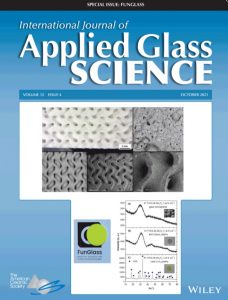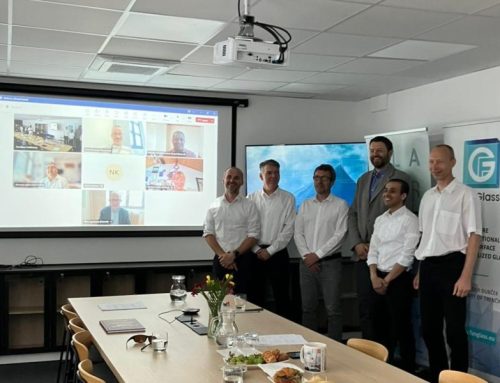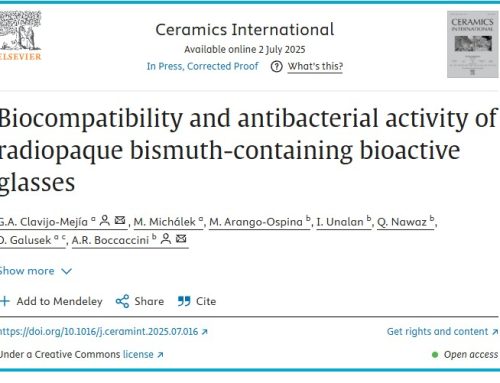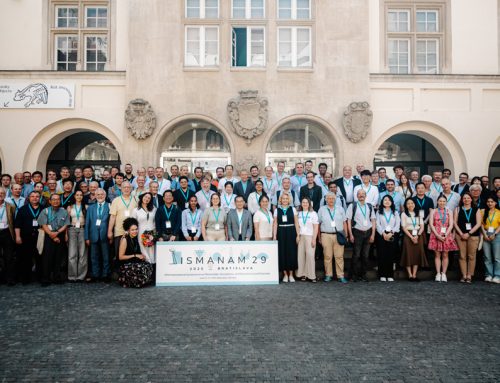International Journal of Applied Glass Science
FUNGLASS: Special issue of International Journal of Applied Glass Science (Vol.12, No. 4) edited by heads of FunGlass partner´s institution: Enrico Bernardo, Aldo R. Boccaccini, Alicia Durán, Dušan Galusek and Lothar Wondraczek.
FunGlass Centre consists of six intensively collaborating research departments sharing transversal research topics. A broad variety of these topics, close collaboration with our partners, and among the FunGlass departments, are documented by the contributions in this special issue.

- Dagupati, R., Klement, R. and Galusek, D.: Er3+/Yb3+ co-doped oxyfluoro tellurite glasses: Analysis of optical temperature sensing based on up-conversion luminescence. Int J Appl Glass Sci., p. 462-471.
Abstract: The effect of Yb3+ co-doping on relaxation dynamics of excited states of Er3+ ion in oxyfluoro tellurite (TZYN) glasses was demonstrated employing excitation and luminescence spectroscopy. The up-conversion luminescence spectra were studied as a function of temperature in the 298–633 K range, and fluorescence intensity ratio (FIR) for green bands due to the 2H11/2 → 4I15/2 and 4S3/2 → 4I15/2 transitions of Er3+ ion against temperature was determined. The temperature sensing performance of TZYN:Er3+/Yb3+ glasses was studied using the FIR technique up to 633 K. The maximum absolute (Sa) and relative (Sr) sensitivity of 0.00246 K−1 at 413 K and 0.72% K−1 at 323 K, respectively, were determined for TZYN:0.5Er3+ /1.0 Yb3+ glass.
- Griebenow, K., Muñoz, F., Tagiara, N.S., Klement, R., Prnová, A., Wolfrum, B., Kamitsos, E.I., Duran, A. and Galusek, D.: Structure and fluorescence properties of Dy-doped alkaline-earth borophosphate glasses. Int J Appl Glass Sci., p. 472-484.
Abstract: Dysprosium-doped borophosphate glasses, containing the divalent cations Mg2+, Ca2+, Sr2+, Ba2+, and Zn2+, are prepared by the melt-quenching technique. The structure of the glasses is investigated by Raman, infrared, and nuclear magnetic resonance (NMR) spectroscopies and the fluorescence properties are determined. The Dy3+ emission lifetime increases with an increasing ionic field strength and its maximum is observed in the Mg2+ and Zn2+ containing glasses. This result can be explained by the stronger M-O bonding which causes a rearrangement of the borophosphate network and creates a local Dy3+ environment of comparably low symmetry. This is in agreement with the Raman spectra and the evolution of the molar volume. The effect of the B/P variation on the emission properties of Dy3+ is investigated in a second series of glasses where the emission lifetime is found to be maximum at 10 mol% B2O3.
- , , , , , , et al.: Structural and optical properties in Tm3+/Tm3+–Yb3+ doped NaLuF4 glass-ceramics. Int J Appl Glass Sci. 2021; p. 485– 496.
Abstract: Transparent NaLuF4 glass-ceramics (GCs) doped with Tm3+ and Tm3+/Yb3+ have been prepared by melting-quenching followed by thermal treatment at temperatures near the glass transition temperature. The crystallization process has been studied using X-ray diffraction (XRD) and high-resolution transmission electron microscopy (HRTEM). NaLuF4 nanocrystals (NCs) ranging 9–30 nm in size are the only crystalline phase, the crystal size increasing with the dopant concentration. Energy dispersive X-ray (EDX) measurements confirm the Tm3+ and Yb3+ incorporation in the NCs. Optical characterization included the analysis of up-conversion (UC) as well as the Near-infrared (NIR) luminescence. NIR emission spectra of Tm3+ and Yb3+ in co-doped samples confirmed an efficient energy transfer between both ions. No UC emissions are observed in Tm3+ single-doped glass and GCs. Yb3+ incorporation favors the Tm3+-Tm3+ UC processes resulting in Tm3+ blue, yellowish-red and NIR UC emissions after excitation at 975 nm. Blue UC emission is also observed in the codoped samples after Tm3+ excitation at 791 nm. These effects were more evident for the GCs compared to the base glasses, confirming the RE ions incorporation in the NCs. As a result, these GCs can be used to tune the UC emission from NIR to blue by selective excitation.
- , , , , , , et al.: Glass-ceramic Ce3+-doped YAG-Al2O3 composites prepared by sintering of glass microspheres. Int J Appl Glass Sci. 2021; p. 497– 508.
Abstract: Sintering by viscous flow in a “kinetic window” between Tg and Tx temperatures was used to prepare bulk glass/glass-ceramic luminescent materials from rapidly quenched glass microspheres in the system Y2O3–Al2O3 doped with Ce3+ ions. The glass microspheres were prepared from sol–gel synthesized precursor powders in a high-temperature methane-oxygen flame. The crystallization of the glasses was analyzed using differential scanning calorimetry and high-temperature X-ray diffraction. The crystallization behavior of quenched glass microspheres was found to be strongly dependent on glass composition. The glass microspheres were consolidated into bulk material by hot-pressing technique at a temperature of up to 1100℃ with the applied pressure 40MPa. The optimized time-temperature-pressure regime enables the preparation of bulk glass, and glass-ceramic with a high fraction of crystalline Ce3+-doped YAG phase embedded in the Al2O3-enriched glass matrix. The glass/glass-ceramics emit blue/yellow light with high intensity under excitation in UV and/or blue spectral region.
- , , , , .: Theta-phase stabilization by rare-earth and alkali incorporation in sol-gel derived alumina. Int J Appl Glass Sci. 2021; p. 509– 518.
Abstract: Bottom-up synthesis of alumina suspensions doped with trivalent (Eu3+) or monovalent (K+) ions is reported as a means to generate crystalline transition-phase alumina with increased thermal stability. Dynamic light scattering was used to track the stability of precursor sols, showing how the dissolved cations contribute to the stabilizing double layer and particle separation in the liquid phase. The incorporation of alkali or rare-earth dopants into the alumina structure further influences the thermal conversion and crystallization behavior. The Kissinger activation energy of the θ → α phase transition in Al2O3 indicates an inhibitory effect of Eu3+ and K+ on the formation of the stable α phase, also confirmed by X-ray diffraction. The intensity ratio of the 7F2/7F1 characteristic photoemission bands of Eu3+ was used to probe the local symmetry as a function of calcination temperature to further corroborate this observation.
- Elsayed, H., Rabelo Monich, P., Savio, G., Hartmann, M., Boccaccini, A.R., Galusek, D., Kraxner, J. and Bernardo, E.: Alkali-free processing of advanced open-celled sinter-crystallized glass-ceramics. Int J Appl Glass Sci., p. 531-540.
Abstract: The cooling of a melt corresponding to the eutectic between wollastonite (CaSiO3) and diopside (CaMgSi2O6) determines the synthesis of an interesting example of alkali-free bioactive glass, easily converted into glass-ceramics featuring two silicate phases, coupled also with åkermanite (Ca2MgSi2O7), by sinter-crystallization of fine glass powders at 1000°C. The fabrication of scaffolds by digital light processing of glass powders suspended in a photo-curable, sacrificial binder, is a well-established technique; the present paper aims at disclosing novel approaches, concerning the topology of scaffolds, offering components with remarkable strength, especially in bending conditions. As an alternative, glass-ceramic foams were fabricated by the firing of porous precursors derived from the gelation of suspensions of glass powders in alkali-free basic aqueous solution.
- , , .: Densification of glass powder studied by master sintering curve and master kinetic curve methods. Int J Appl Glass Sci. 2021; p. 541– 550.
Abstract: The master sintering curve method was applied to analyze the sintering and crystallization behavior of 15Na2O.10CaO.75SiO2 (SLS) and 17Na2O.33CaO.50SiO2 (NC2S3) glasses, in mol %. The densification of samples was successfully analyzed using the master sintering curve (MSC) method; it gives activation energy Q = 310–340 kJ.mol−1, which is in good agreement with the expected activation energy of the viscous flow. While the obtained activation energy enables predicting the sintering behavior of SLS glass, the actual results are different from the estimated data for NC2S3. The activation energy of crystallization of NC2S3, determined by constructing Master Kinetic Curves (MKC) was lower than the sintering activation energy: this impairs the prediction ability of MSC for NC2S3 glass.
- , , , , , .: Åkermanite glass microspheres: Preparation and perspectives of sinter-crystallization. Int J Appl Glass Sci. 2021; p. 551– 561.
Abstract: Glass microspheres with the exact stoichiometry of åkermanite (Ca2MgSi2O7), one of the most promising modern bioceramics, were produced by the flame synthesis method. The distinctive high cooling rate was found to prevent the crystallization; the size of amorphous microbeads could be correlated with the size of partially crystallized precursor powders, deriving from conventional melt quenching and milling. The glass microspheres were characterized in terms of crystallization and sintering behavior, in the perspective of applications in additive manufacturing of åkermanite-based scaffolds. The results showed that merwinite (Ca3MgSi2O8) is the primary product of glass devitrification; only in a second stage, merwinite reacts with the residual glass and yields åkermanite. The rapid crystallization, implying limited viscous flow sintering, was tested as an opportunity to create components with complex porosity distribution.
- , , , , , , et al.: Low-alkali borosilicate glass microspheres from waste cullet prepared by flame synthesis. Int J Appl Glass Sci. 2021; p: 562– 569.
Abstract: Although glass recycling is considered to be a default method for glass waste management, fine fractions of container soda-lime glass, or cullet of other compositions are still landfilled. This happens despite existing alternatives. Success could lie in advanced upcycled products that bring higher economic motivation for the implementation in industry, but these are often connected to alternative ways of product synthesis. We provide an example of waste glass upcycling by the preparation of glass microspheres (GM) from specialty low-sodium alumino borosilicate-based glasses via flame synthesis (FS). GM and the precursors, either from colorless medical vials or glass fibers, were characterized by scanning electron microscopy (SEM), simultaneous thermal analysis coupled with differential thermal analysis (STA-DTA), and image analysis. A dynamic corrosion test was performed and evaluated via ion-coupled plasma with optical emission spectroscopy (ICP-OES) to observe corrosion kinetics products. FS has proved to be a fast method of waste glass processing into GM. This article, besides the characterization of the starting material and final products, also suggests the possibility of processing for other landfilled waste glasses and also discusses the manufacturing of GM for water filters and fillers for polymers.
- , , , , , , et al.: New glass-based binders from engineered mixtures of inorganic waste. Int J Appl Glass Sci. 2021; p. 570– 580.
Abstract: Aluminum is one of the most important strategic resources, but the Bayer process, typically applied for the purification of ores, leads to vast amounts of alkaline slurry waste, known as red mud. Though interesting for potential reprocessing, red mud is still predominantly stored in big slurry pools, due to high levels of toxic metals. Toxic ions can be easily immobilized by vitrification, but the high costs of this solution need to be balanced by the reuse of the obtained glass. The present paper is dedicated to the transformation of waste-derived glass into new binders for the construction industry, according to both “conventional melting” and “smelting” approaches. In the first case, red mud was included in a mixture of waste, designed to yield a reactive glass (CMG), that is, forming stable gels after activation in an alkaline aqueous solution. In the second approach, red mud was subjected to a thermal treatment in a reductive atmosphere, implying the separation of molten iron alloy. The remaining glassy slag, according to its chemical composition (CaO and Al2O3-rich) underwent gelation by simple interaction with pure water, without any alkaline activator, thus configuring a new “glass cement.”
- Liška, M., Macháček, J., Chromčíková, M., Holubová, J. and Černošek, Z. : Thermodynamic model of ZnO-Nb2O5-P2O5 glasses – parameterization and validation. Int J Appl Glass Sci., p. 581-587.
Abstract: On the basis of experimental structural data ten system components were considered in the ZnO-Nb2O5-P2O5 thermodynamic model of Shakhmatkin and Vedishcheva – ZnO, Nb2O5, P2O5, ZnP4O11, Zn(PO3)2, Zn2P2O7, Zn3(PO4)2, NbO(PO3)3, (NbO)4(P2O7)3, and NbOPO4. The molar Gibbs energies of ZnO, Nb2O5, P2O5, and Zn3(PO4)2 were taken from the FACT database. The unknown Gibbs energies of the other components were estimated by minimizing the sum of squares of deviations between the calculated and measured equilibrium molar amounts of system components for the series xNb2O5·50ZnO·(50-x)P2O5. The model was validated by the Multivariate Curve Resolution (MCR) and Malfait’s analysis of Raman spectra of xNb2O5·(50-x)ZnO·50P2O5 glasses. The MCR analysis performed for three components resulted in loadings that were in acceptable coincidence with partial Raman spectra obtained by Malfait’s decomposition. Both the MCR and the Malfait’s decomposition reproduced the experimental Raman spectra very well – on the level of experimental error.
- , , , , , .: Polymer (PCL) fibers with Zn-doped mesoporous bioactive glass nanoparticles for tissue regeneration. Int J Appl Glass Sci. 2021; p. 588– 600.
Abstract: Composite fibrous membranes based on poly(ɛ-caprolactone) (PCL) and mesoporous bioactive glass nanoparticles (MBGNs) were fabricated by electrospinning. MBGNs and Zn-doped MBGNs prepared by microemulsion sol–gel method were successfully incorporated inside the polymeric fibers of 240 and 385 nm in diameter for undoped and Zn-doped PCL_MBGNs fibers, respectively. Thermal analysis showed that the concentration of MBGNs reached a maximum of around 21 wt% for Zn-doped MBGNs. Both PCL_MBGNs and PCL_MBGNs_Zn composite membrane exhibited bioactivity after immersion in simulated body fluid (SBF). X-ray diffraction (XRD) and Fourier transform infrared spectroscopy (FTIR) showed the evolution of composite membranes, confirming the formation of hydroxyapatite (HAp). However, the degradation products of membranes did not affect the viability and proliferation of murine stromal cells (ST-2) and thus the new fiber structures represent a suitable environment for cell adhesion. Therefore, the incorporation of mesoporous glass nanoparticles doped with therapeutically active Zn2+ ions inside the PCL fibers offers the possibility to create a multifunctional biomaterial suitable for drug delivery and tissue engineering.
- Talimian, A., Nowicka, A., Kaňková, H., Sani, G., Galusková, D., Wondraczek, L. and Galusek, D.: Two-step ion-exchanged soda lime silicate glass: Effect of surface compression on silver ion release. Int J Appl Glass Sci., p. 601-612.
Abstract: Although glass plays an important role in medical facilities such as countertops or interfaces of medical equipment, where chemical and mechanical durability is of great concern, less attention has been paid to developing durable anti-microbial surfaces. In the present work, silver-containing surfaces were produced by ion exchange in soda-lime silicate float glass, and the effects of residual surface compression produced by ion-exchange on the release of silver ions were investigated. Silver-doped surfaces were prepared by a sequential two-stage ion-exchange process in pure potassium nitrate, at 450°C for 4-24 hours, and subsequently in KNO3+ 1 wt% AgNO3, at 400°C for 10-30 minutes. Silver ions were found to penetrate 3-5 µm into the glass surface, causing only a limited decrease in surface compression induced by potassium ions. The silver-rich layer provides the required Ag+ leaching essential for anti-microbial applications, as confirmed by Ag+ ion leaching tests. The silver release can be altered by surface compression.
- Hruška, B., Nowicka, A., Chromčíková, M., Greiner-Wrona, E., Smolík, J., Soltézs, V. and Liška, M.: Raman spectroscopic study of corroded historical glass. Int J Appl Glass Sci., p. 613-620.
Abstract: The corroded surfaces of historical glass samples were studied by micro-Raman spectroscopy. The spectra acquired from lateral and stratified mapping were analyzed by principal component analysis providing the number of linearly independent spectral components and by multivariate curve analysis resulting in spectrum of native glass and spectra of different corrosion products (loadings) and their relative abundances (scores) in each measured spot. The obtained results were qualified by comparison of results obtained by stratified mapping with the results of lateral mapping. On the basis of dominant scores, the lateral distribution of various corrosion products was identified. The quality of corrosion products was only roughly identified by the spectral database (S.T. Japan spectral database).












